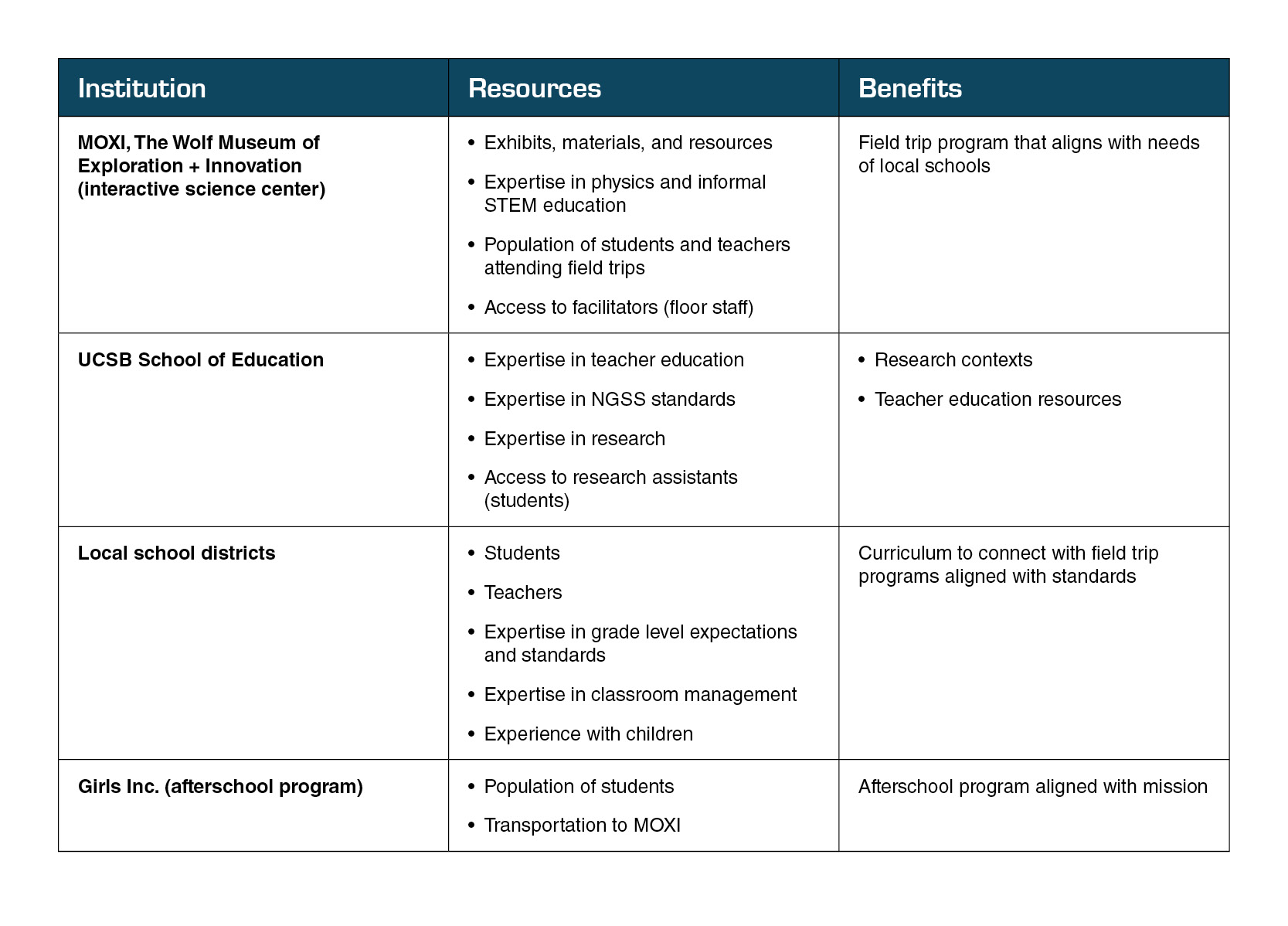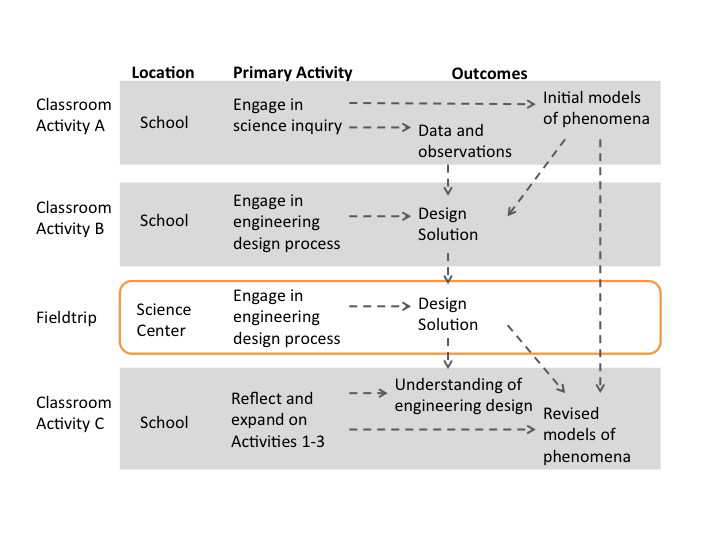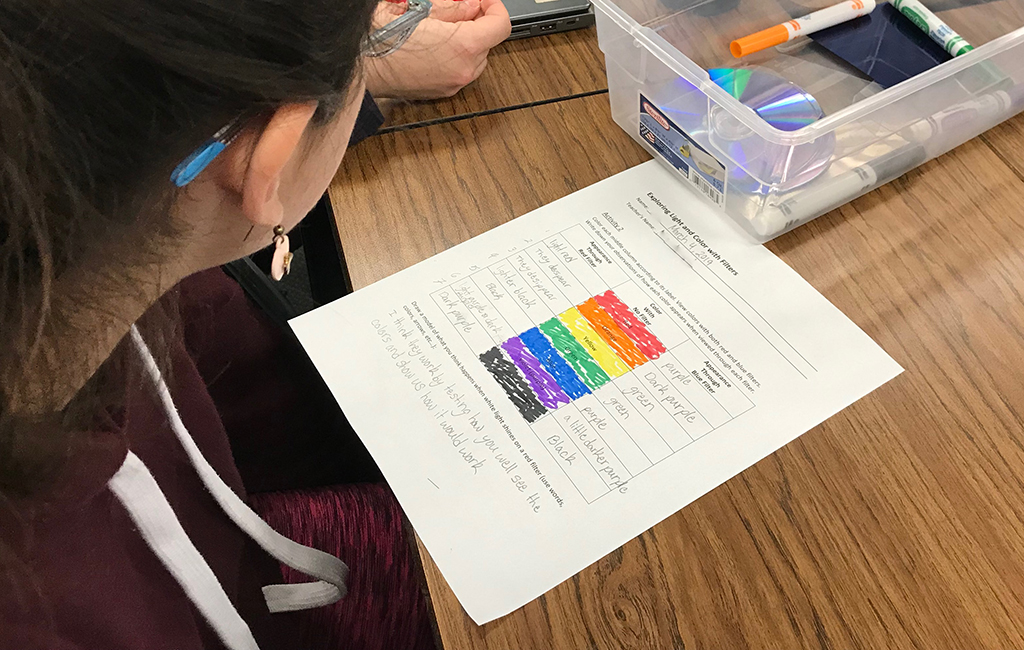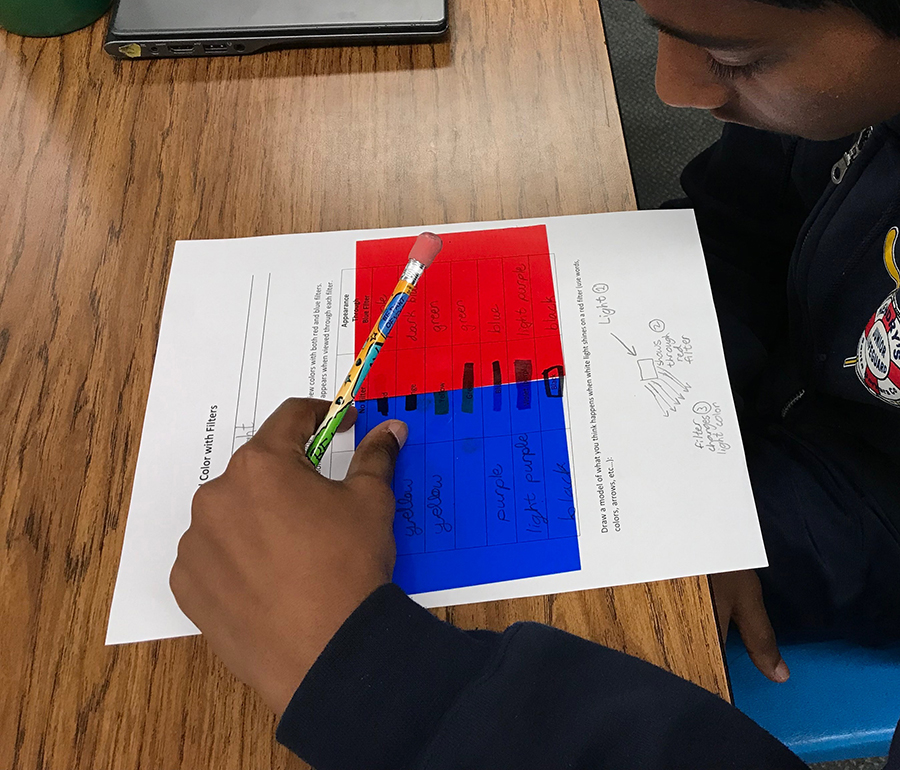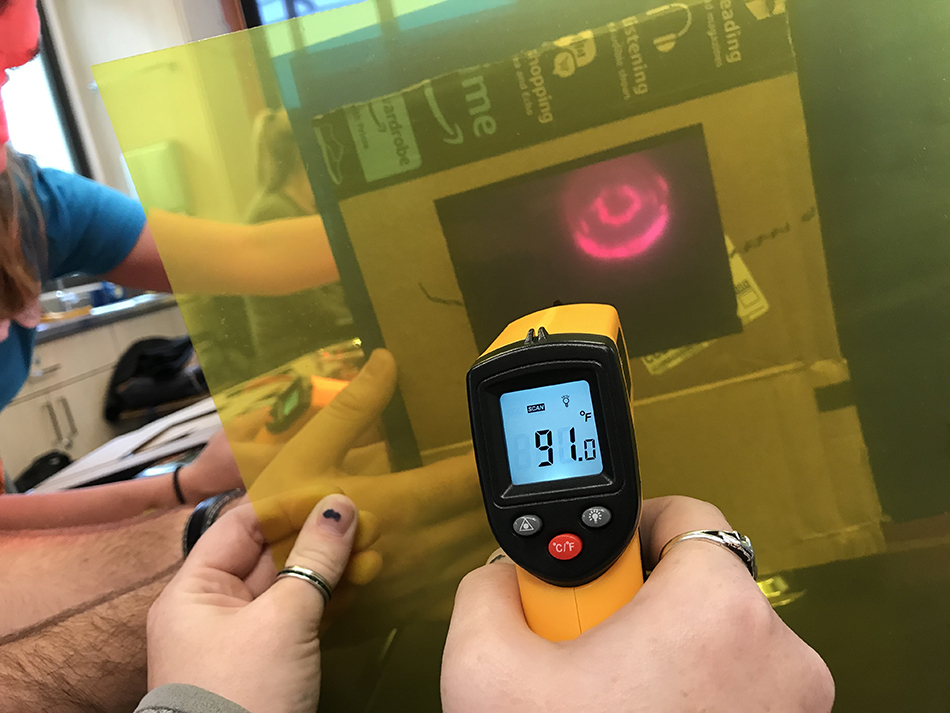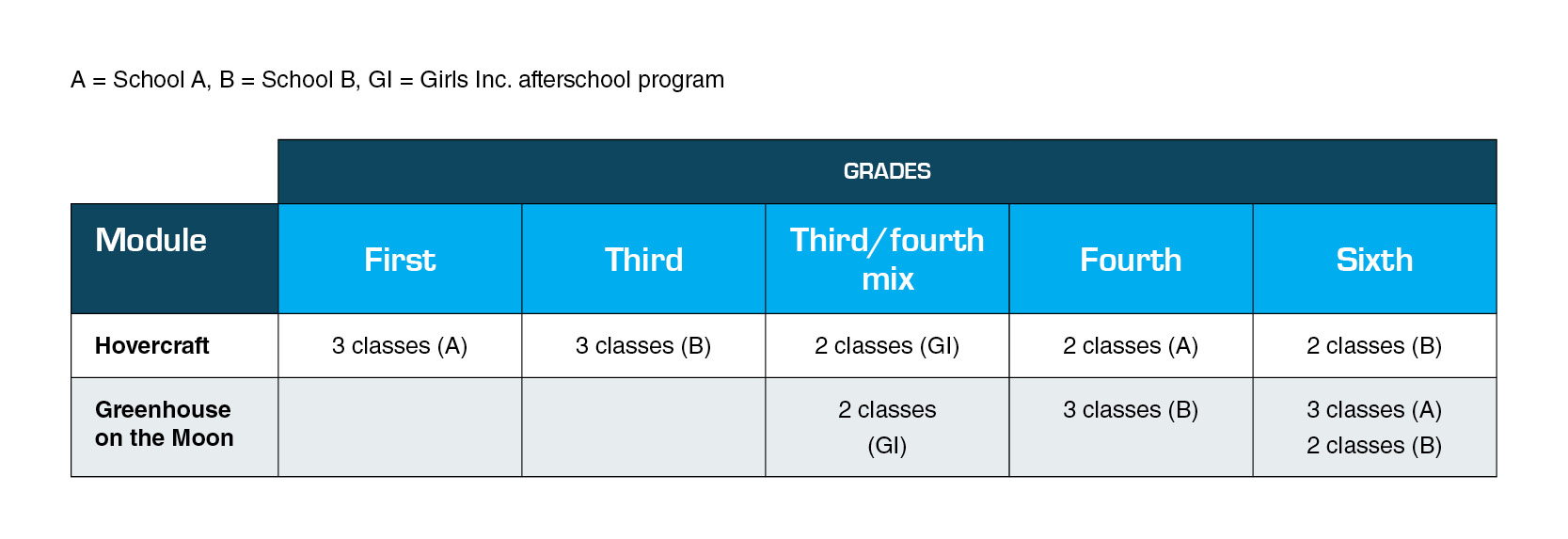Research to Practice, Practice to Research
Partnering to Develop a Coordinated Engineering Education Program Across Schools, Museum Field Trips, and Afterschool Programs
Connected Science Learning January–March 2020 (Volume 2, Issue 1)
By Danielle B. Harlow, Ron Skinner, Tarah Connolly, and Alexandria Muller
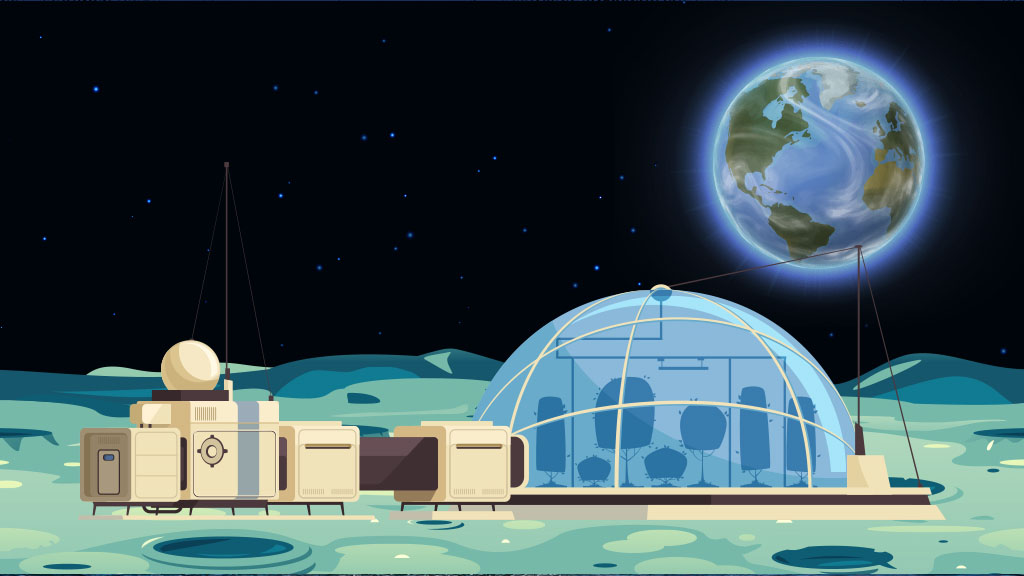
Engineering Explorations are curriculum modules that engage children across contexts in learning about science and engineering. We used them to leverage multiple education sectors (K–12 schools, museums, higher education, and afterschool programs) across a community to provide engineering learning experiences for youth, while increasing local teachers’ capacity to deliver high-quality engineering learning opportunities that align with school standards. Focusing on multiple partners that serve youth in the same community provides opportunities for long-term collaborations and programs developed in response to local needs.
In a significant shift from earlier sets of standards, the Next Generation Science Standards include engineering design, with the goal of providing students with a foundation “to better engage in and aspire to solve the major societal and environmental challenges they will face in decades ahead” (NGSS Lead States 2013, Appendix I). Including engineering in K–12 standards is a positive step forward in introducing students to engineering; however, K–12 teachers are not prepared to facilitate high-quality engineering activities. Research has consistently shown that elementary teachers are not confident in teaching science, especially physical science, and generally have little knowledge of engineering (Trygstad 2013). K–12 teachers, therefore, will need support.
Our goal was to create a program that took advantage of the varied resources across a STEM (science, technology, engineering, and math) education ecosystem to support engineering instruction for youth across multiple contexts, while building the capacity of educators and meeting the needs of each organization. Specifically, we developed mutually reinforcing classroom and field trip activities to improve student learning and a curriculum to improve teacher learning. This challenging task required expertise in school-based standards, engineering education, informal education, teacher professional development, and classroom and museum contexts.
Partners
Interactive science museums have materials, tools, and expertise that differ from schools and can provide educational and compelling engineering experiences that complement what students are learning in formal school curricula (Bell et al. 2009). Coordinated school-based and museum-based engineering education programs allow children to engage in rich instruction, but this curricular cohesion is just the first step. Teachers must also develop the expertise and confidence to facilitate classroom activities that align with new standards and expectations around teaching engineering in the classroom. The Engineering Explorations modules involve four types of institutions: higher education (University of California, Santa Barbara [UCSB]), an interactive science center (MOXI, The Wolf Museum of Exploration + Innovation), an afterschool program (Girls Inc.), and two elementary schools (grades K–6). These institutions are all located within a 15-mile radius of each other and serve the same local population of schoolchildren. The institutions were already familiar with each other through previously established partnerships and collaborative projects that had emerged through local connections and mutual interests.
The primary partnership is between the practice-based institution, MOXI, and researchers at UCSB. MOXI and UCSB have formed a research practice partnership (RPP) (Coburn, Penuel, and Geil 2013) that has produced multiple interacting programs and related research. The RPP has focused on the array of learning experiences across schools and informal institutions, as well as research to inform facilitation techniques and training methods that support learning in the STEM disciplines. See Harlow and Skinner (2019) for an overview of the RPP’s multiple interacting programs and research directions, as well as Table 1 for more information about the partners.
Table 1
Resources of the four institutions and benefits to them by participating in Engineering Explorations
Program motivation and development
During the 2017–2018 academic year, MOXI implemented field trip programs in which students engaged in an engineering design problem. Although students and teachers responded positively to the program, we recognized the limitation of having only 50 minutes with students. Also, teachers often requested resources for their classroom instruction. This motivated the development of the Engineering Explorations modules. Each Engineering Explorations module is composed of a set of four activities: The first two activities are done in classrooms prior to attending a MOXI field trip, the third activity is the field trip, and the fourth activity is completed in the classroom after the field trip (see Figure 1). Currently these pre- and postactivities are run as outreach programs facilitated by MOXI and UCSB staff in students’ regular classroom. However, our goal is to develop resources and activity plans for teachers so that they can implement the engineering activities in their classrooms before and after their field trip to the museum.
Our work follows a design-based research model (e.g., Anderson and Shattuck 2012; Barab and Squire 2004). Design-based research is “a systematic but flexible methodology aimed to improve educational practices through iterative analysis, design, development, and implementation, based on collaboration among researchers and practitioners in real-world settings” (Wang and Hannafin 2005, p. 6). Consistent with recommendations for design-based research (Anderson and Shattuck 2012), our project is situated in a real educational context, is focused on designing and testing a significant intervention, uses mixed methods, involves multiple iterations, and involves a collaborative partnership.
We began designing each Engineering Exploration module by developing the field trip activity. Because not all students who participate in the field trip activity do the pre- and postclassroom activities, the field trip programs must be designed as stand-alone activities. Classrooms that attend the MOXI field trip without having completed the previsit activities still participate in a design challenge based on a real-world problem that engages them in the process of engineering design.
After developing the field trip lesson, we considered the engineering and science activities that would benefit students in developing a deeper understanding of science and engineering ideas during the field trip program. Figure 1 depicts the framework that guides our module development. The first activity (done at school) engages students in a science investigation, through which they collect data and make observations. During this activity, students also draw their initial conceptual models of the phenomena being investigated. In the second in-class activity, students complete an engineering task. Their designs are informed by the data and observations made during the earlier activity. During these two preactivities, students also become familiar with some of the materials they will use during the field trip and develop skills related to manipulating these materials. At MOXI students engage in a more complex engineering task. After the field trip, they return to their classrooms and extend their learning through reflection on the activities, the engineering process, and additional data analysis, which includes revising their conceptual models of the phenomena being investigated.
Thus far, two modules have been developed and tested. One module is designed around the engineering task of designing a craft that will hover in a column of upward-moving air while supporting a small weight (Muller et al. 2019); the second module is based on combining layers of materials that will allow for the transmission of optimal amounts of visible light and infrared radiation (Connolly, Skinner, and Harlow 2019). Both modules are differentiated for grade level bands. Following, we describe the activities in the module that focuses on the transmission of visible light and infrared radiation through various materials.
Example Engineering Explorations module: Greenhouse on the Moon
The “Greenhouse on the Moon” module was designed around a MOXI field trip activity in which students design a “patch” for a lunar greenhouse by layering materials and testing the transmission of light and infrared radiation. Through piloting this activity, we determined that students would be more prepared to develop deeper understanding during the field trip program if they had prior experiences to help them develop a conceptual model of a filter as a material that absorbs and transmits light and infrared radiation. Thus the module begins with two preactivities that help students develop an understanding of filters through both science and engineering activities. All four activities (the three classroom activities and the field trip activity) are designed to take 50 minutes each (an entire module would require 200 minutes).
Preactivity 1
To help students build their knowledge of these concepts before the field trip, we designed a previsit activity that focused on a data-collection task in which students recorded what color they observed when they looked at different colors through a red or blue filter. They first make observations while looking through colored filters to see how each filter changes the appearance of various color images and other colors and patterns around the classroom (similar to the activity in DeVita and Ruppert 2007). Students then conduct a scientific investigation in which they use the filters as tools to make observations. Next, students use those observations to construct a table of colors with notes and documentation on how those colors appear when viewed through a red or blue filter. Students are told that the data table they create in this lesson, which maps visible colors to their filtered appearances, will be a resource for solving an engineering design challenge in the subsequent lesson (see Figure 2).
Preactivity 2
The second previsit activity introduces the idea that light travels as waves and that there are some types of light we cannot see with our eyes. The second part of the lesson involves an engineering design challenge: Deduce the original colors of a Rubik’s Cube. Students are given matching images of a Rubik’s Cube, but one is obscured by a red filter and the other is obscured by a blue filter (see Figure 3). Using the data they collected in the first lesson, students engage in a comparative analysis process to “reverse-engineer” the original image using filters, their color charts, and their understanding of the effects filters have on colored images. They then use colored markers to design a secret message that is revealed only when observed through a colored filter.
At the end of the activity, students reflect on their findings and “Draw a diagram or describe with words what they think will happen when a red or blue filter is placed over an image.” Together, these prelessons prime students with the ideas that the colors we see are a type of light, and there are types of light we cannot see. The activities also give students hands-on experience with filters that reduce or block different types of light, which supports the task in the field trip program. By introducing students to these ideas and materials, students’ participation and intentional iteration in the engineering design challenge during the field trip are subsequently enhanced.
Field trip activity
This activity was inspired by exhibits and resources unique to the interactive science museum, such as infrared cameras. Students are welcomed into the museum’s classroom space, the Exploration Lab, and are immediately engaged in a live demonstration using an adapted version of visual thinking strategies (Yenawine 2013). In our case, the strategies consist of a discussion about a demonstrated phenomenon structured around three questions (“What do you think is going on? How do you know? What more can you see?”) to elicit their ideas about light and heat, the electromagnetic spectrum, and the effects that different materials have on the transmission of light and heat (see Connolly, Skinner, and Harlow 2019). Students are then presented with the design challenge of identifying the best materials for repairing a greenhouse on the Moon, which has specific criteria for the levels of visible light and infrared heat that are allowed to enter. Students iteratively test and measure different combinations of materials against a model of the Sun—a heat lamp—using infrared thermometers and lux meters to determine which materials they would recommend to repair the greenhouse, while meeting the given criteria (Figure 4).
Postactivity
The postvisit lesson extends the field trip by integrating additional elements of the engineering design process and connecting the field trip to the classroom curriculum. In this case, the postvisit activity involves an optimization task (NGSS disciplinary core idea ETS-1C) in which students are prompted to select a solution from a set of fabricated options while optimizing for the added variable of cost. Solution A is ineffective at meeting the light and temperature criteria but is very affordable. Solution B meets both criteria perfectly but is exceptionally expensive. Solution C is moderately priced but does not meet the criteria as closely as Solution B. Students are required to consider the pros and cons of each option and make an argument in favor of one. As a grade-level differentiation, the lesson can be adapted to require students to calculate the percentage of light or heat allowed by the provided solutions to inform their recommendations.
Together, the activities in this four-part module engage students in the NGSS performance expectation 4-PS3-2 (“Make observations to provide evidence that energy can be transferred from place to place by sound, light, heat, and electric currents”), as well as the three disciplinary core ideas related to engineering (Defining Problems, Designing Solutions, and Optimizing Solutions) (NGSS Lead States 2013).
Adding the afterschool (Girls Inc.) component
We partnered with Girls Inc. to adapt and combine the modules for a 10-week afterschool program, which took place at MOXI. For the afterschool participants, we increased the time spent on hands-on activities. Additional time to explore the museum was also included in their program.
Evaluation
We continuously evaluate and conduct research on the program with the goals of
- designing an effective program to engage children in engineering design, and
- understanding the needs of teachers who will ultimately implement the program.
We collect a variety of data, including student work, pre- and postassessments, observations, and interviews and surveys of teachers.
The Engineering Explorations field trip program was implemented at MOXI with over 100 classrooms of students ranging from grades K–6. We tested the full modules, which include pre- and postactivities and the field trip program, with 18 classrooms located at two schools. School A identified 40% of its students as English language learners, with 62% of students qualifying for free and reduced-price lunches. School B identified 9% of its students as English language learners, with approximately 11% of students qualifying for free or reduced-price lunches. We also worked with an afterschool program that served girls in the local area. In the test classrooms, we collected video of all four activities with 15 of the 18 classrooms, interviewed participating teachers, and collected student work. Facilitators of the activities wrote reflective field notes. Table 2 shows the number of classes from the two test schools. The hovercraft module is appropriate across elementary grade levels and the Greenhouse on the Moon module is appropriate for upper elementary school students.
Table 2
Test classrooms
The teacher interviews indicate a positive response across grade levels. One said, “Kids were engaged; they got exposure to things that they may not have before, especially as far as trying to improve upon something that they previously had started working on or their ideas that they had. That’s not something that they do too much of.” Another reported that the program was “the first time that I’ve had a chance to see engineering lessons being taught to kids this young so I was very curious how it was going to go. Was it going to be too high level for them or how it was going to be presented to them on a level that they were going to be able to understand? I thought it was fabulous. They loved it.” However, the teacher interviews also point to difficulties that children encountered. A fourth-grade teacher mentioned how the concept of infrared radiation (which is not visible) was hard for students to comprehend based on the activities that were done in the classroom, which focused on visible light. She encouraged more guided discussions about radiation that is not visible.
The student work demonstrates both developing understanding of the engineering process and students’ thinking about the science ideas. When asked in the final activity how the work they did at MOXI was like the work of an engineer, one student stated, “I think engineers have to plan things before time and collaborate with their team like we did. I also think that they must fix their mistakes and use trial and error.” One science idea that was used across multiple activities in the greenhouse module was that of materials acting as filters, allowing some wavelengths of light to travel through while blocking others. In the classroom activities, students used filters that transmitted some colors and not others. In the MOXI activity, students used materials that transmitted or blocked infrared and visible light to varying degrees. During the first round of testing, we asked students to write and draw their ideas about how the materials at MOXI worked to block and transmit light and heat at the end of the module. Students’ ideas ranged from the filters changing the light, giving the light a color, or filtering out some colors and allowing some to pass through (see Figure 5 for three examples of sixth graders’ work). Through this research, we were able to better understand the range of student ideas during and after participating in the module. This helped us adjust our facilitator training materials for the field trip to better address common misconceptions that students were showing and revisit the structure of the lessons to include additional practice and experience with colored filters in the preactivities. In this way, the classroom activities allowed us to improve the field trip activities, benefiting all students who attended field trips, not just those who participated in the full module with the classroom activities.
Figure 5
Student work from the final activity of the module.
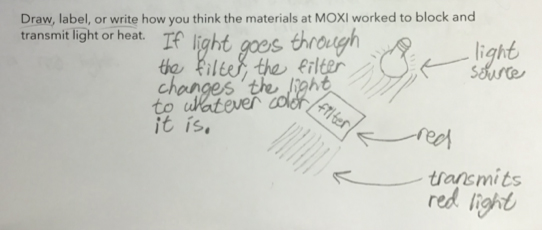
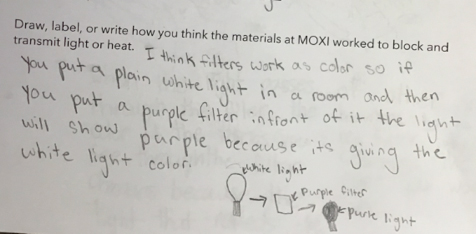
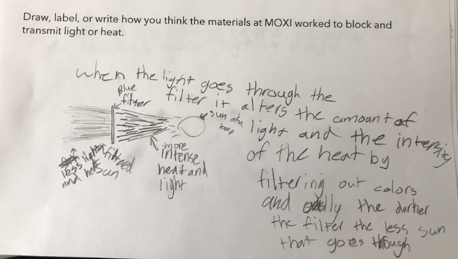
Challenges
In our work to develop a program that resulted in learning across contexts—classrooms, museum trips, and afterschool programs—we identified multiple challenges.
Challenge 1: Developing activities that work as stand-alone activities and can be embedded in a larger module
Classrooms that attended MOXI field trips were not required to complete the preactivities. Thus, the field trips had to work as a stand-alone activity. However, we also wanted the field trip activity to be designed in a way that could build on knowledge developed in the previsit activities for the classes that participated in them. As described above, we addressed this by first developing the field trip activity and then identifying the key concepts to develop in the classroom activities. During the testing phase, we knew which classes had participated in the full module and which had only participated in the field trip. However, this would not always be the case. So, during the testing phase, we ran the same program with students who had participated in the modules as those who had not. Through our interviews with teachers and observations of classrooms, we identified that this resulted in students (and teachers) not fully understanding the goal of the preactivities until they were presented with the design challenge during the field trip, making the initial activities potentially feel disconnected. In the coming year, we will develop initial activities that outline the design challenge of the entire module during the first preactivity to provide a more explicit story line for students.
Challenge 2: Developing age-appropriate activities
Unlike classrooms, which typically include students of one grade level, students attending museum field trips considerably vary. First graders may visit one day and sixth graders the next, and each group requires different implementations. To reduce the training and development burden for the museum, we developed activities that could be implemented across a wide range of grades. However, as students acquire key math and literacy skills during their K–12 years, they become more capable of complex work. Although we did develop different versions of data collection worksheets for different grade levels, the largest adjustments needed to be made in the classroom activities. We developed multiple versions of the pre- and postactivities (grades 3 and 4, grades 5 and 6) and relied upon collaboration with K–12 teachers to help inform this process (see Muller et al., forthcoming).
Challenge 3: Scheduling
The goal of Engineering Explorations was to have the classroom extensions be supplemental to the field trip, which required them to be scheduled close enough together that students did not forget the material. Also, teachers needed to make sure that there was enough time blocked off for the 50-minute activity, and MOXI needed to ensure that there were staff available to run the outreach activities. These requirements made scheduling a significant challenge to the implementation of Engineering Explorations.
Conclusion
Developing modules that include some activities designed for classroom environments and other activities designed for a field trip to an interactive science museum enables a richer learning experience for students that takes advantage of the unique resources of both schools and museums. Museums have specialized resources and materials (e.g., exhibits) that differ from the materials available in typical school settings. They are also not accountable to state and district standards. Together, this means that museums can provide STEM opportunities that are not possible in typical classrooms. However, the time that any one group of students is in a museum for a field trip is limited. In contrast, because students are in the same classroom each day, schools can provide extended opportunities for learning over several days. The series of activities in Engineering Explorations takes advantage of schools’ and museums’ structures and resources. Students who participate in the full modules have opportunities to develop ideas at a level that would be impossible in a single 50-minute lesson typical of a museum field trip program, while using the museum environment for experiences they could not have in their classroom. Combining school and field trip activities into coherent learning experiences addresses the challenge of bringing high-quality engineering education into K–12 classrooms and allows for rich learning experiences across multiple contexts.
Acknowledgments
This material is based upon work supported by the National Science Foundation (grant EEC-1824858; EEC-1824859).
Danielle B. Harlow (danielle.harlow@ucsb.edu) is professor of science education at the University of California, Santa Barbara in Santa Barbara, California. Ron Skinner (Ron.Skinner@moxi.org) is the director of education at MOXI, The Wolf Museum of Exploration + Innovation, in Santa Barbara, California. Tarah Connolly (Tarah.Connolly@moxi.org) is the curriculum specialist at MOXI, The Wolf Museum of Exploration + Innovation, in Santa Barbara, California. Alexandria Muller (Almuller@ucsb.edu) is a graduate student researcher at the University of California, Santa Barbara in Santa Barbara, California.
Curriculum Engineering Informal Education



